The newest entry in the Anno series offers a mix of familiar elements and refreshing changes that fit surprisingly well into its new setting. For the first time, we’re building cities during the ancient era—right in the heart of the Roman Empire at its peak, which is a very welcome shift from the colonial and futuristic time periods we’ve seen before.
If you’re a fan of the series, you already know what’s waiting for you: a complex spreadsheet disguised as a gorgeous city builder. If you’re not, the whole idea of this city-building game revolves around three key pillars: organising resource production chains, establishing logistics and trade routes between cities, and managing urban infrastructure. Everything connects like a puzzle that becomes more difficult and intricate as you solve it. It doesn’t sound very easy because, well, it is. But once everything clicks, you get the same dopamine rush as landing a Rampage in Dota or a headshot in CS.
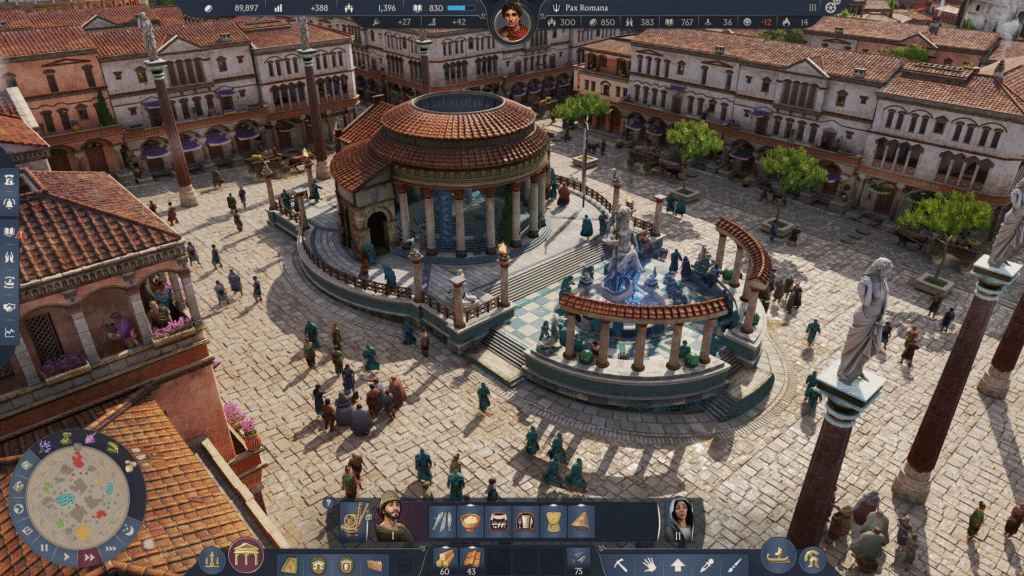
The concept is simple enough on paper: you start with a map filled with islands, and you begin on one of them. There, you found your first settlement, built up basic construction materials, and started housing your first citizens—Libertus. They require access to specific goods that you must produce to satisfy their needs, which are grouped into categories like Food, Public Service, and Fashion. Higher tiers of citizens will later demand things like Households and Marvels. You’ll start by meeting basic food needs, say, sardines, by placing a Fishery on the shore that catches fish and delivers it to your warehouse, and a Porridge stand that requires an Oat Farm to supply it. That’s how every production chain works: one building produces resources for another, which in turn supplies your people. As the game progresses, the system becomes more complex.
Every production building also consumes Workforce; basically, it requires a certain number of citizens to function. That means you can’t simply promote everyone to higher social tiers, because even your humble farmers are essential to keep the Patricians supplied with wine, olive oil, and other luxuries. You’ll need to plan your production carefully, as each resource has a different production speed. For instance, wool takes 30 seconds to produce, while hats take a full minute, and require that wool. You can also use wool to make sails, just as you can use hemp to make togas, or, of course, rope. Togas and hats are for your citizens, while rope, sails, and wood are used to build ships.
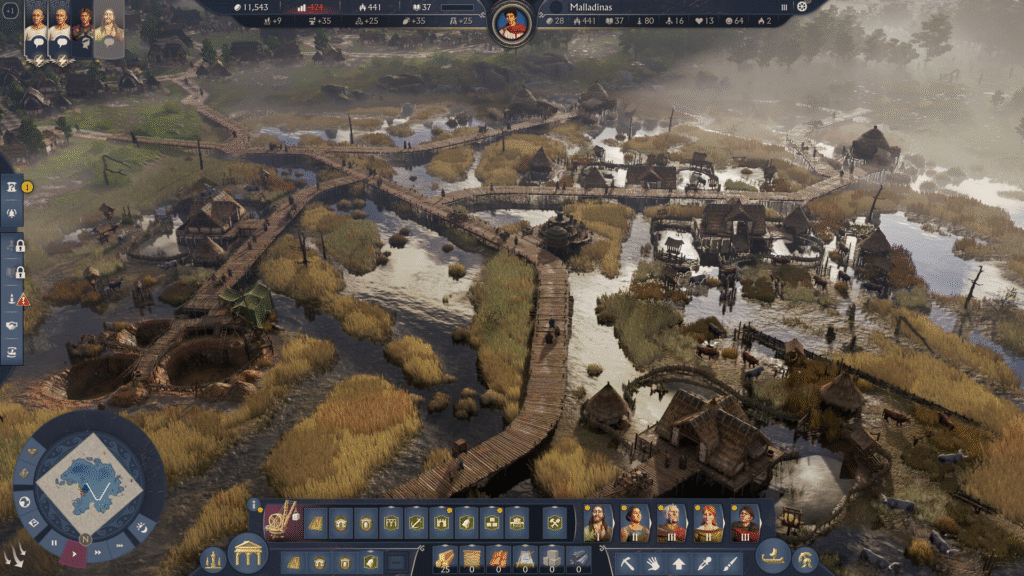
Once you’ve met every requirement for your Libertus, you can upgrade their houses, turning them into Plebian residences. The Plebeians will then have new, more complex needs, and satisfying them allows you to advance your population to Equites, and eventually Patricians, who will finally let you build the Colosseum, the crowning jewel of your city’s prestige. Getting there isn’t easy, though. Your starting island will soon run out of resources, forcing you to expand and colonise new islands using your ships, spreading your influence and creating logistical nightmares in the process.
The game features two regions—Latium and Albion—and you can start in either one. Latium represents the Mediterranean, where you can only develop Latin culture, while rainy, swampy Albion lets you develop native Celtic culture or assimilate it into the Latin one. Depending on your choice, you’ll gain access to different production chains. Later, when expanding to new islands, you can also choose which culture to develop, and it’s actually useful to have both—it’s one of the most interesting new mechanics in the series so far. Eventually, you can settle in both regions, unless you’d rather spend a fortune importing rare resources. That’s because higher citizen tiers demand goods only available in other regions. For example, the third citizen tier in Latium, Nobles, requires cheese, which can only be produced in Albion. Because, as we all know, cows don’t exactly thrive in the Mediterranean. Technically, you can promote your population even without every resource, as long as the overall category (like Food or Luxury) is adequately fulfilled.
That’s the core loop of Anno: expand your influence, conquer new islands, grow your cities and power faster than rival governors, who are optional, so you can also enjoy a peaceful, solo expansion across the map without interference.
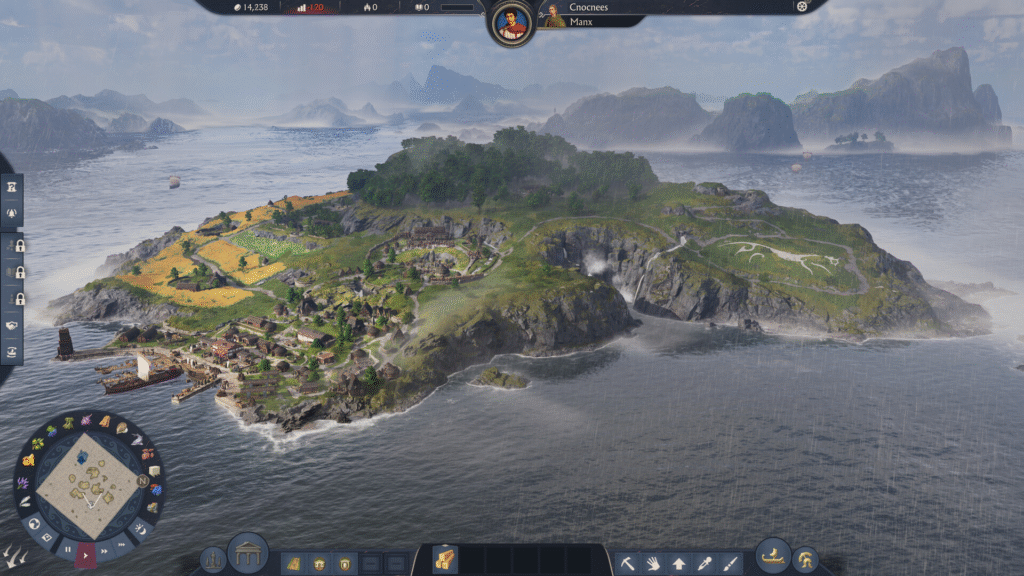
The game currently features two modes: Campaign and Endless. The Campaign acts as a solid tutorial, walking you through the game’s mechanics. You can finish the story in a few hours, and once it’s done, you can continue freely in Endless mode. In the campaign, you choose between two protagonists, brother or sister, and while they don’t differ much aside from dialogue, you take the role of a governor appointed by the Emperor to oversee the island of Julia, named after his wife and chosen heir. The story is short and not particularly engaging, but it does a good job of introducing both regions’ mechanics.
Later, you’ll have to decide whether to ally with the Celts resisting Roman influence—or, as I did, crush their gods and idols, burn their farms, and subjugate everything that can be subjugated. I mean, come on—am I Roman or not? After freeing the Celts from their “free will,” you return victorious, earn your triumph, and continue the game however you wish. I honestly expected the story to pick up from there, perhaps leading into a civil war between two heirs to the throne, where you’d choose a side, but no. That’s the end of the campaign. A bit disappointing, especially compared to older entries like Anno 1404, which had an exciting and challenging story with memorable late-game missions.
Endless mode is the sandbox of the game, and you can fine-tune every setting, from AI opponents and resource availability to consumption rates and pirate aggression. You can play solo, in co-op, or against other players as rival governors. Even as rivals, you can cooperate and trade, or declare war if things go south.
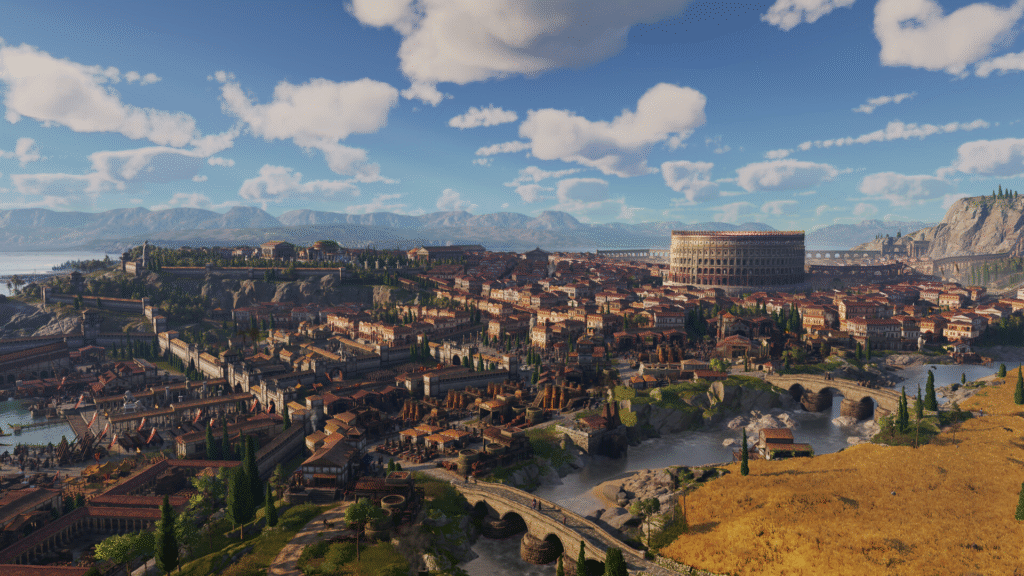
Anno 117 introduces several new mechanics to the series.
Religion lets you choose a patron deity for each island—Roman gods like Ceres, Mars, Neptune, and Minerva, or Celtic gods in Albion. Each provides unique production bonuses and effects for that island, allowing you to specialize your settlements. Other AI governors, and even the Emperor or Empress, will react positively or negatively to your divine choices. The Empress, for example, keeps scolding me for “sacrificing” Celts to Mars (he’s just my patron god, relax), but she’ll regret it once I declare independence. Yep—you can actually do that in this game.
Research is another new addition, bringing tech trees that unlock bonuses for buildings, new cults, improved military units and ships, and new structures like Watchtowers, stone walls, and Latrines that boost Health. The research branches are divided into three paths: Economic, Civic, and Military.
Diagonal building also makes its debut—roads can now curve naturally, and buildings will snap to them, though their rigid shapes sometimes make the layouts a bit awkward. Luckily, you can toggle that off.
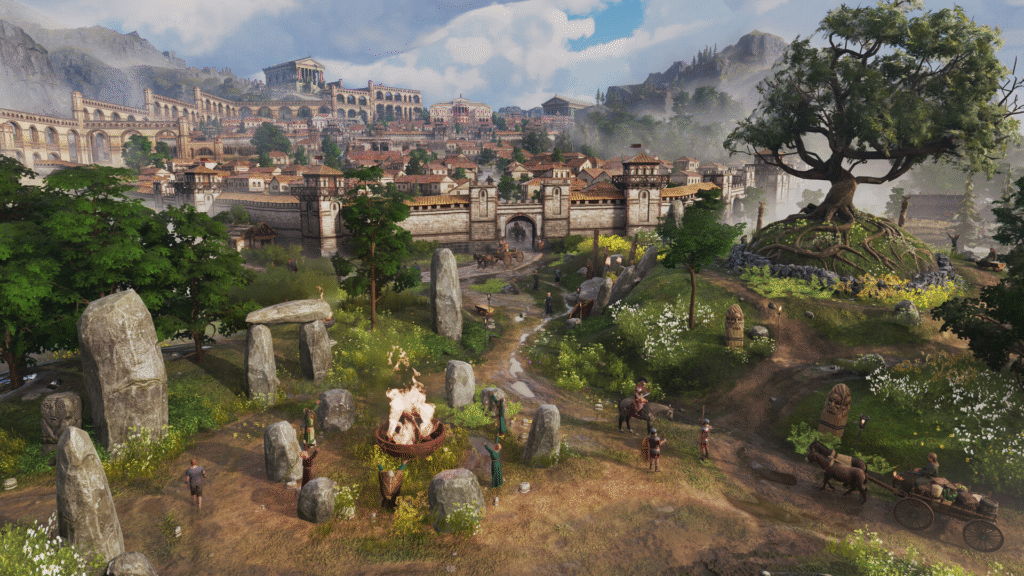
The return of land units is something fans have been asking for—though personally, I wasn’t one of them. For me, Anno is about trade, logistics, shipping routes, and building beautiful cities. Managing multiple islands, trade networks, fleets, and naval battles is demanding enough; land armies feel unnecessary. That said, having legions camped near your cities is undeniably cool to look at. The combat resembles a simplified Total War system, with each unit consisting of a dozen or so soldiers. Three main unit types form a rock-paper-scissors balance: archers beat spearmen, spearmen beat cavalry, and cavalry trample archers. All can burn enemy buildings with torches—and no, they can’t capture them. They have to, very slowly, torch them down one by one. It’s a mechanic that felt outdated twenty years ago. Things speed up once you unlock ballistae, though.
Ships are divided into warships and trade vessels, and naval combat mostly involves firing arrows at each other until one sinks, which feels a bit underwhelming, considering that the Romans were historically poor sailors who turned sea battles into land skirmishes using boarding ramps. That would’ve been such a cool mechanic to include here. Ship AI is also a bit odd: they stop moving whenever given new orders, and, strangely, there’s no option for faster ships to match speed with slower ones—a feature that’s been in every previous Anno. So now, when you send warships to escort your fragile traders, they’ll rush ahead, leaving them defenceless against pirates. By the time your “protectors” turn back, your merchant ship is already at the bottom of the sea.

Every building has an impact—bakeries and brickworks increase fire risk, sardine stalls reduce happiness and health, while others boost profits or improve overall well-being. Happiness itself is affected by fire safety, health, war, and even how often the Empress scolds you.
You can engage in diplomacy with other governors, each with unique personalities and preferences. Some respect strength and military might; others care about how you treat your neighbours. You can sign trade agreements, non-aggression pacts, defence pacts, and full alliances. Everyone also competes on the status ladder in the Emperor’s (or Empress’s) favour. At the start, you choose whether the ruler is Emperor Calidus or Empress Juliana, and depending on your rank in their favour, you’ll get perks or penalties. Fall too low, and you might even go to war with the ruler, who’ll start sending fleets your way. I haven’t yet tried full rebellion mode, but it’s on my to-do list. This mechanic goes all the way back to Anno 1701, and I’ve always loved it. Why pay taxes to the nobility when you can just build your own Villa?

For each AI character, you can take on small quests – little errands like “bring me this,” “pick that up,” or “destroy that ship over there.” It’s nothing new, but it does feel odd that there aren’t any quests tied to land units.
Aside from money and resources, completing missions also earns you Specialists, which can sometimes be purchased from traders as well. These provide various bonuses to nearby buildings or citizens – like extra income from houses or a 50% boost in production speed for certain goods.
But the biggest problem with any Anno game is simply stopping. There’s always one more thing to fix, one more shipment to organize, one more factory to optimize, and two hours later, the game pops up a message saying: “You’ve been building for 4 hours, how about a coffee?” It actually reminds you to get up and stretch – which says a lot about how dangerously addictive it can be.
Visually, the game is stunning. Islands, rivers, and water shimmer beautifully. Buildings, details, and people walking around or working bring everything to life. Whether you zoom in close or pull back to admire the whole city, it’s a treat to watch your creation function like a living organism. Water effects are far superior to previous entries. Even if you turn all settings down to low, it still looks impressive enough to enjoy the view. Latium bursts with vibrant colors and sunny coastlines, while Albion is rainier, windier, darker, and harsher – perfectly reflecting their cultural and stylistic contrasts. Even the loading screens are gorgeous, filled with inspiring concept art that helps you immerse yourself in your growing empire.
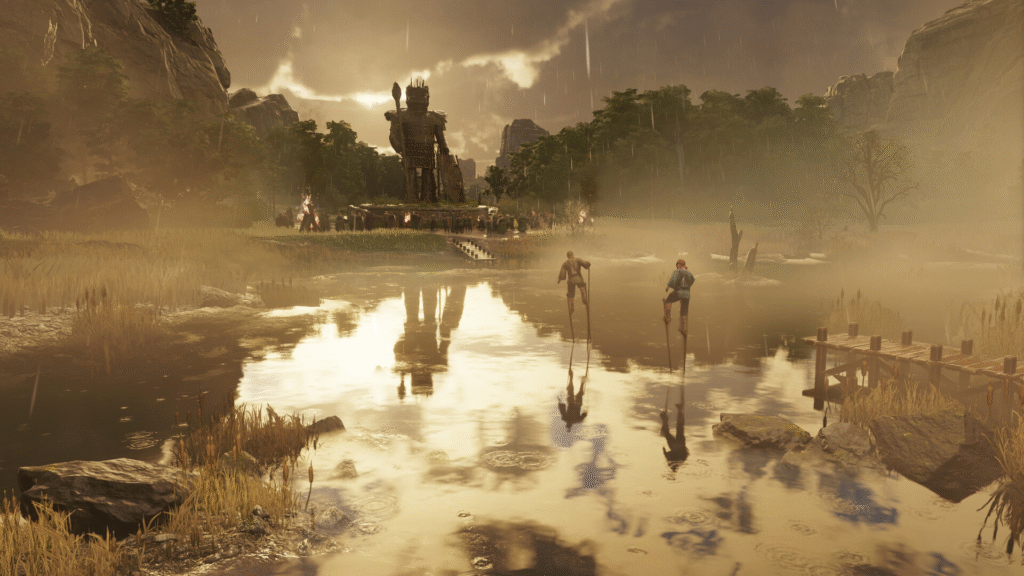
Like the rest of the settings, the graphics options are incredibly detailed, so you can tweak everything to your liking and rig. I played on an ultrawide monitor, and everything fit perfectly – UI, controls, display, all neatly adjustable and highly customizable.
Performance-wise, I had only one minor issue: long loading times. It might be something to investigate further, but it’s not a dealbreaker. Rendering took a bit longer at the start, but once everything loaded, it ran beautifully. I didn’t experience a single crash, and only one bug where a quest refused to trigger – after reloading my save, it worked fine. I played on PC, and the game also supports cross-play, which will definitely please a lot of players.
The UI, however, is probably the weakest part. The organisation of build options is… strange. Once you get used to it, it’s manageable, but early on I was completely confused. Why split everything like this? The previous game had a perfect layout, so this change makes little sense. There’s also no way to save preset layouts with the Stamp tool – for some reason, that feature is just gone. On the plus side, you can adjust the UI scale and tweak a ton of display settings, which helps.
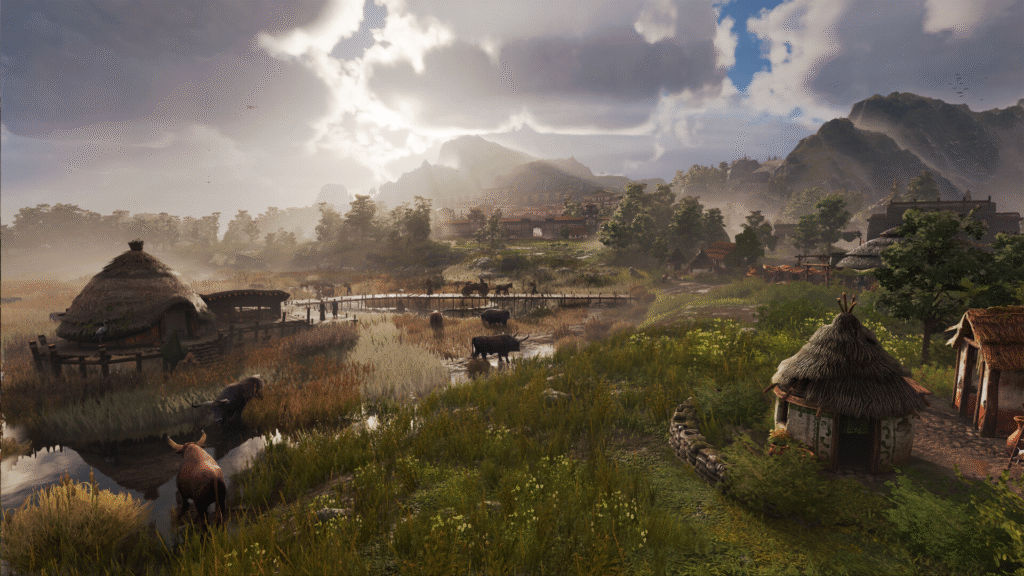
The map itself looks great and is easy to navigate. My only complaint here is again tied to quest display – you can only view one active quest at a time. The others are hidden, and you have to hover your mouse to reveal them. Notifications are divided into several categories, and you can disable some if they get annoying.
Trade routes are well designed this time around and allow for a lot of customisation, which fixes a few older frustrations. My only gripe, and veteran players will understand this, is that when you open your trade routes and hover over a transported resource, it doesn’t show you how much of it you have across all islands. That feature used to be there, and it was super helpful for a quick overview. Now, you can only see that info while selecting the resource – a small but noticeable step back.
Public Service buildings have a specific radius of influence. When you select, say, a Marketplace, the surrounding roads turn green, showing which houses are covered. It would be incredibly useful to see the influence areas of all Marketplaces at once, not just the one you’re currently selecting. That used to be possible, and now you’re forced to check house by house to ensure coverage. Later, when you have a ton of public service buildings, it becomes a real hassle to keep track of what’s covered and what isn’t. I really hope this gets patched.

Effects like happiness and fire safety are represented by weird numerical values that don’t make much sense. At one point, my happiness dropped to -870, and I had no idea why. The menu said “City status: no data available,” so I had no clue what to fix. A few hours later, happiness mysteriously improved on its own.
When you finish a mission and need to deliver goods to an NPC, you have to sail all the way to them and click on a tiny lighthouse to trigger the delivery pop-up. I don’t understand why they added that extra step. It used to trigger automatically as soon as you arrived with the required goods, even if your camera wasn’t focused there.
Sometimes, clicks wouldn’t register properly. I’d try to select something, and the game would highlight a nearby object instead. The Move tool felt clunky, too; it often grabbed roads or elements I didn’t want, and snapping would suddenly shift in the last second, messing up my placement. Also, when an AI Governor offered a deal or sent a message, I could still hear them talking for a full minute in the background after I closed everything.
Some tutorial pop-ups wouldn’t disappear properly, continuing to show up even hours later, despite closing them or completing their objectives.
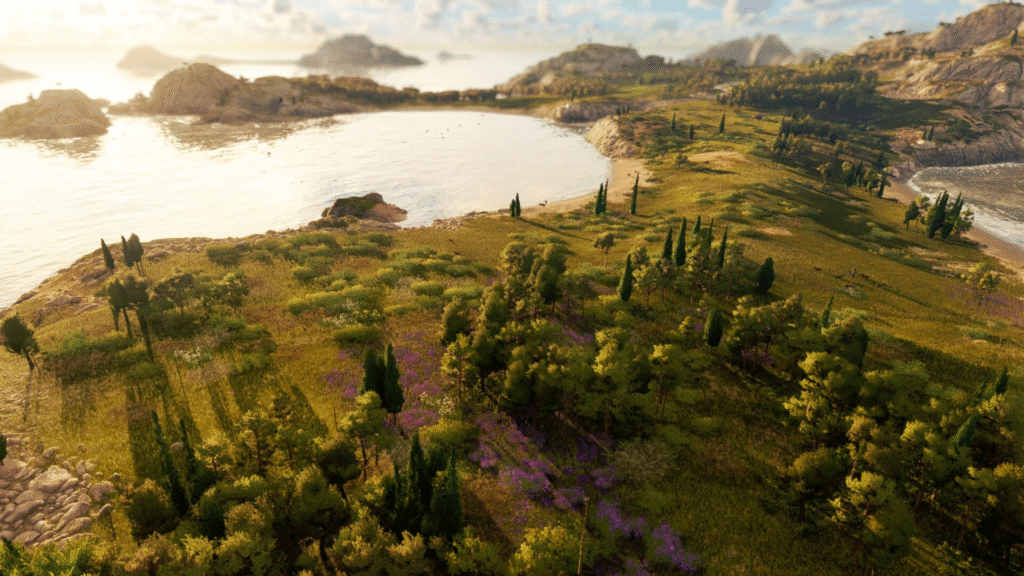
When building roads with diagonal mode enabled, the tool sometimes created awkward extra corners I didn’t want, forcing me to delete and redo them.
As mentioned earlier, the game features two main regions and maps. Moving between them triggers a short loading screen of a few seconds – a bit of a downgrade compared to Anno 1800, which had five regions (with all expansions) and zero load times when switching between them.
The selection of AI Governors is also quite small – just seven of them, the fewest ever in an Anno game, which is disappointing. They still only simulate another player instead of truly following the same rules as humans. They develop freely even if you blockade their ports or destroy their fleets – basically, they cheat. Sadly, that hasn’t changed.
The Scenario mode, which previously offered short missions with unique storylines and challenges, is missing too. There’s also no Sandbox mode, which would allow unrestricted building with everything unlocked right away – perfect for players who just want to create beautiful cities instead of managing them. Maybe that’s something we’ll get later.

The Anno dev team has always had a great reputation and good communication with players. Past titles evolved significantly through updates that fixed issues and added new features, so I hope that continues. Many of these small problems could easily be fixed in future patches.
Mods are supported again, which is great news since they can help solve some of these issues and further enrich the experience. Fantastic decision by the developers, and I can’t wait to see what creative ideas the modding community comes up with.
As before, the game teaches you some things but throws you into the fire for others, leaving you to figure it out. Newcomers might struggle at first, but with experimentation and repetition, you’ll quickly get better. And since the game is very customizable, you can start your first playthrough with very easy conditions.

We would like to thank Ubisoft for providing us with a copy of the game for review purposes.

